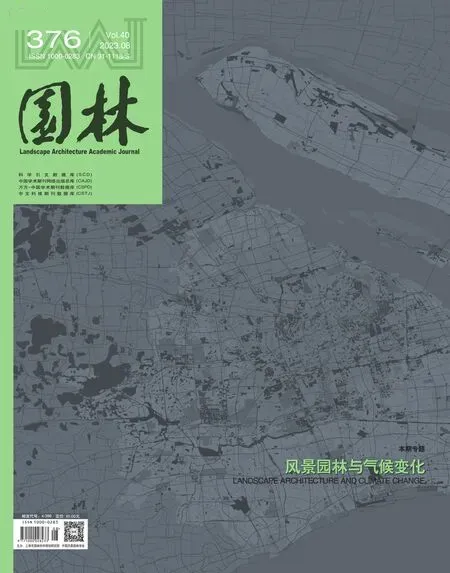应对气候变化背景下的风景园林途径
近日,中国气象局国家气候中心组织的盛夏(7-8月)全国气候趋势及主要气象灾害预测会商会在北京召开,预计盛夏极端天气事件偏多,阶段性强降水、暴雨洪涝、高温热浪等灾害较重。气候变化议题起源于20世纪中叶,现已成为国际政界、学术界、非政府组织和公众关注的焦点。2021年联合国气候变化大会(COP26)以及IFLA气候行动承诺都强调从减缓与适应两个方面应对气候变化危机。《中国应对气候变化的政策与行动》白皮书指出,积极应对气候变化,共谋人与自然和谐共生之道。从《巴黎协定》的达成与落实,到对于“双碳”目标的庄严承诺,再到碳达峰、碳中和“1+N”政策体系的构建,无不彰显着中国政府应对气候变化的坚强决心。
风景园林自古遵循并秉承天人合一的哲学思想,观察自然规律、顺应自然规律,在气候变化的背景下,可发挥其优势以诠释人与自然的共生之道。从减缓与适应角度出发,通过可持续规划设计、水资源管理、碳减排与节能措施、生态系统保护和修复,以及科技创新与合作、公众教育与参与等方式,一方面形成全生命周期规划设计的主动干预,提供依托生态智慧、生态技术的不断更新的应对策略与手段,有效减缓气候变化的不利影响;另一方面不断提高城市韧性,使得城市能够更好地适应气候变化带来的诸多影响。
本期专题“风景园林与气候变化”,从碳循环、城市韧性、植物适应性、土地变化、生态修复、智慧理水等多个方面开展研讨,以探求风景园林与气候变化共生之路径。以中国城乡融合“碳平衡、碳循环”为目标,分析国外城乡融合典型案例,总结了适用于国内实践经验和新时代现代化发展要求的城乡融合发展模式;探讨基于韧性城市的复合基础设施的设计原则,展示了宁波生态走廊提高城市韧性的设计策略;聚焦北京植物园45种园林树木物候的年代际变化,揭示不同树种、各物候阶段的物候响应特征和响应敏感性差异;模拟预测了4种发展情景下郑州市2029年的土地利用变化,评价不同发展情景下城市森林生态系统健康,总结最优土地利用策略;以夏季重庆北碚缙云山山火后的迹地修复为例,提出了极端气候下城市森林林火迹地的修复与管理策略;以广西北流市的降雨变化为研究对象,运用ArcGIS空间分析法分别从宏观、中观、微观三个层面探究了广西北流市鸭埌村的生态治水智慧。
应对气候变化背景下风景园林规划设计应对途径的研讨,可促使风景园林人的进一步思考与实践,以秉持着人与天调、人地共生为目标,积极探索适应气候变化的韧性人居环境建设策略,是天人合一、万物并育的中华智慧的具体体现,也是彰显风景园林人积极应对气候变化的责任担当。
主编
2023年7月12日
Approaches to Landscape Architecture in the Context of Climate Change
Recently, the National Climate Center of China Meteorological Administration(NCCA) organized the National Conference on Climate Trends and Prediction of Major Meteorological Disasters at the height of summer (July-August), which was held in Beijing.It is expected that the extreme weather events at the height of summer will be on the high side, and the disasters of phased heavy precipitation, heavy rainfall and flooding, and high temperature and heat waves will be heavier.The topic of climate change, which originated in the mid-20th century, has become a focus of international political, academic, non-governmental organization and public attention.The 2021 United Nations Climate Change Conference (COP26), as well as the IFLA Climate Action Commitment, both emphasize addressing the climate change crisis in terms of both mitigation and adaptation.The White Paper onChina’sPoliciesandActions inResponsetoClimateChangepoints out that it is important to actively respond to climate change and to seek a harmonious coexistence between human beings and nature.From the conclusion and implementation of theParisAgreement, to the solemn commitment to the “dual-carbon” target, to the construction of the “1+N” policy system of carbon peaking and carbon neutrality, all of these have demonstrated the Chinese government’s strong determination to respond to climate change.
Since ancient times, landscape architecture has followed and adhered to the philosophical thinking of the unity of man and nature, observing and adapting to the laws of nature, and in the context of climate change, they can give play to their strengths in order to interpret the way of symbiosis between human beings and nature.From the perspective of mitigation and adaptation, through sustainable planning and design, water resource management, carbon emission reduction and energy saving measures, ecosystem protection and restoration, as well as scientific and technological innovation and cooperation, public education and participation, on the one hand, the formation of the whole life cycle of planning and designing the active intervention, to provide constantly updated coping strategies and means relying on the ecological wisdom, ecological technology, and effective mitigation of the adverse effects of climate change; On the other hand, we will continue to improve the resilience of cities so that they can better adapt to the many impacts of climate change.
The topic of this issue, “Landscape Architecture and Climate Change”, discusses carbon cycle, urban resilience, plant adaptability, land change, ecological restoration, smart water management and other aspects, in order to explore the approach of symbiosis between landscape architecture and climate change.Taking “carbon balance and carbon cycle” of China’s urban-rural integration as the goal, the typical cases of urban-rural integration in foreign countries were analyzed, and the urban-rural integration development mode was summarized for domestic practical experience and the requirements of the new era; the design principles of composite infrastructure based on resilient cities were explored for showing the design strategy of Ningbo Eco-Corridor of improving urban resilience; the inter-decadal changes in the phenology of 45 species of garden trees in Beijing Botanical Garden were analyzed to reveal the phenological response characteristics and response sensitivity differences among different tree species and phenological stages; the land use changes in Zhengzhou City in 2029 under four development scenarios were simulated and predicted, the health of urban forest ecosystems under different development scenarios was evaluated; The rainfall changes in Beiliu City, Guangxi was taken as the research object for exploring the ecological water management wisdom from macro, meso, and micro levels by using the ArcGIS spatial analysis method respectively.
The discussion of approaches to cope with landscape architecture planning and design in the context of climate change can lead to further thinking and practice of landscape architects.With the goal of adhering to the harmony between man and nature, and the coexistence of man and earth, we should actively explore the construction strategy of resilient human settlements to adapt to climate change.It is a concrete embodiment of the Chinese wisdom of Unity of Heaven and humanity,and the coexistence of all things, and it also highlights the responsibility of landscape architects to actively respond to climate change.
Editor-in-Chief
July 12th, 2023

